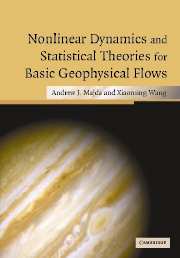Book contents
- Frontmatter
- Contents
- Preface
- 1 Barotropic geophysical flows and two-dimensional fluid flows: elementary introduction
- 2 The response to large-scale forcing
- 3 The selective decay principle for basic geophysical flows
- 4 Non-linear stability of steady geophysical flows
- 5 Topographic mean flow interaction, non-linear instability, and chaotic dynamics
- 6 Introduction to information theory and empirical statistical theory
- 7 Equilibrium statistical mechanics for systems of ordinary differential equations
- 8 Statistical mechanics for the truncated quasi-geostrophic equations
- 9 Empirical statistical theories for most probable states
- 10 Assessing the potential applicability of equilibrium statistical theories for geophysical flows: an overview
- 11 Predictions and comparison of equilibrium statistical theories
- 12 Equilibrium statistical theories and dynamical modeling of flows with forcing and dissipation
- 13 Predicting the jets and spots on Jupiter by equilibrium statistical mechanics
- 14 The statistical relevance of additional conserved quantities for truncated geophysical flows
- 15 A mathematical framework for quantifying predictability utilizing relative entropy
- 16 Barotropic quasi-geostrophic equations on the sphere
- Index
13 - Predicting the jets and spots on Jupiter by equilibrium statistical mechanics
Published online by Cambridge University Press: 30 November 2009
- Frontmatter
- Contents
- Preface
- 1 Barotropic geophysical flows and two-dimensional fluid flows: elementary introduction
- 2 The response to large-scale forcing
- 3 The selective decay principle for basic geophysical flows
- 4 Non-linear stability of steady geophysical flows
- 5 Topographic mean flow interaction, non-linear instability, and chaotic dynamics
- 6 Introduction to information theory and empirical statistical theory
- 7 Equilibrium statistical mechanics for systems of ordinary differential equations
- 8 Statistical mechanics for the truncated quasi-geostrophic equations
- 9 Empirical statistical theories for most probable states
- 10 Assessing the potential applicability of equilibrium statistical theories for geophysical flows: an overview
- 11 Predictions and comparison of equilibrium statistical theories
- 12 Equilibrium statistical theories and dynamical modeling of flows with forcing and dissipation
- 13 Predicting the jets and spots on Jupiter by equilibrium statistical mechanics
- 14 The statistical relevance of additional conserved quantities for truncated geophysical flows
- 15 A mathematical framework for quantifying predictability utilizing relative entropy
- 16 Barotropic quasi-geostrophic equations on the sphere
- Index
Summary
Introduction
Prominent examples of long-lived large-scale vortices in geophysical flows are those such as the Great Red Spot (GRS) on Jupiter (Dowling, 1995; Marcus, 1993; Rogers, 1995). The emergence and persistence of such coherent structures at specific latitudes such as 22.4° S for the GRS in a background zonal shear flow that seems to violate all of the standard stability criteria (Dowling, 1995) are a genuine puzzle. Here we show how to utilize the equilibrium statistical theory with a suitable prior distribution, ESTP, introduced in Section 9.2 and discussed in Chapters 10, 11, and 12 to predict the actual coherent structures on Jupiter in a fashion which is consistent with the known observational record. As discussed in Section 9.2, the statistical theory is based on a few judiciously chosen conserved quantities for the inviscid dynamics such as energy and circulation and does not involve any detailed resolution of the fluid dynamics. The key ingredient of the ESTP is the prior distribution, Π(λ), for the one-point statistics of the potential vorticity which parameterizes the unresolved small-scale turbulent eddies that produce the large-scale coherent structures. Below, we show how the observational record of Jupiter from the recent Galileo mission suggests a special structure for such a prior distribution resulting from intense small-scale forcing. Recall from the studies discussed in Chapter 12 (DiBattista, Majda, and Grote, 2001) that ESTP can potentially describe the meta-stable large-scale coherent structures occurring from strong small-scale forcing, provided that the flux of energy to large scales is sufficiently weak.
- Type
- Chapter
- Information
- Publisher: Cambridge University PressPrint publication year: 2006



